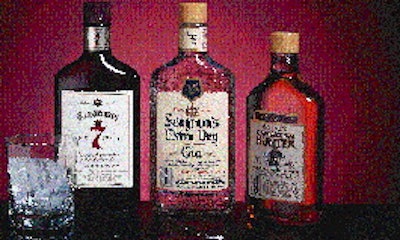By adding an automated uncaser to a 375-mL glass flask filling line at its Lawrenceburg, IN, bottling plant last November, Joseph E. Seagram & Sons Inc. boosted that line's speed to 300 bpm from 240 bpm. "Before November, we had two operators manually unloading cases," says Jim Thesing, the plant's bottling maintenance engineer. "It was the slow point on the line." Adding a Model 156 unloader/ single filer from A-B-C (Tarpon Springs, FL), he says, "was vital to increasing the line's speed." Despite its enhanced efficiency, automated uncasing provided the plant with a challenge. "When we uncased bottles manually, the bottles were dumped right-side-up onto a table, positioned in a six-row-wide by four-row-long configuration. Bottles tended to stay oriented as the leading row of six bottles moved single-file onto a perpendicular conveyor that carried them downstream in proper alignment," Thesing explains. "With automated unpacking, bottles come out in the same configuration, but all 24 move across a 10-foot area that contains about 15 [conveyor-like] sections positioned next to one another. To help single-file the bottles, each of these sections runs a little bit faster the farther you get away from the uncaser. During this process some of the bottles rub against one another, and some may spin themselves around. About 90 percent of the bottles remain in proper orientation, but the remaining 10 percent need to be oriented." Each flask has a curved shape with definite front and back panels. Handles two sizes To rectify the situation, Seagram added Bottling Development's (Waterloo, Ontario, Canada) first BD2700 rotary orienter. While the machine was custom designed for the Lawrenceburg plant, it's now available commercially. What makes the orienter especially functional for Seagram is not just that it properly realigns bottles, but how quickly it adapts to two separate 375-mL flask shapes that might otherwise prove vexing for the same line to handle. Bottles for Seagram's Seven Crown whiskey and Extra Dry Gin are virtually identical in size. Owens-Brockway (Toledo, OH) provides the 9.05" H x 3.75" W x 1.6" D bottles. The third bottle, for Canadian Hunter whiskey, has a shorter neck and is decidedly more squat in shape. Supplied by Ball-Foster Glass Container (Muncie, IN), this bottle stands 7.875" H x 3.06" W x 1.68" D. Thesing says orienter changeovers can be made within minutes to accommodate either bottle size. "The key to the orienter is its quick-changeover capability," says Thesing. "It's easy and fast." The changes include replacing a feedscrew and center guide and making bottle height adjustments-none requiring tools. Efficient operation Thesing says the line runs about 18 days per month. In operation, the unloader/single filer inverts the corrugated reshipper. Major flaps fall away from the case. Minors are mechanically opened, so the inverted bottles gently fall onto their bases on an unloading belt. Empty cases are conveyed to downstream case packing. Bottles proceed to the chain conveyor system for single filing. Bottles then enter the BD2700 rotary orienter's infeed starwheel where a photoeye senses each incoming bottle. The information is relayed to an Allen-Bradley (Milwaukee, WI) 503 programmable logic controller. Should a bottle be aligned incorrectly, the PLC can signal the machine to turn the bottle to its proper orientation once it advances into the main turret. The infeed star transfers bottles to the turret, where each bottle is positioned onto a pedestal, with a mechanically timed bell device clamping the top of the bottle. The machine is designed to eliminate the need for pedestal change parts for different bottles. Once oriented, bottles return to the line, where they proceed through cleaning, filling, capping, labeling, drop packing, case sealing and palletizing functions on existing equipment. "The combination of the quick-change orienter and the unloader makes us more efficient at less cost," summarizes Thesing. "That's a successful combination."



